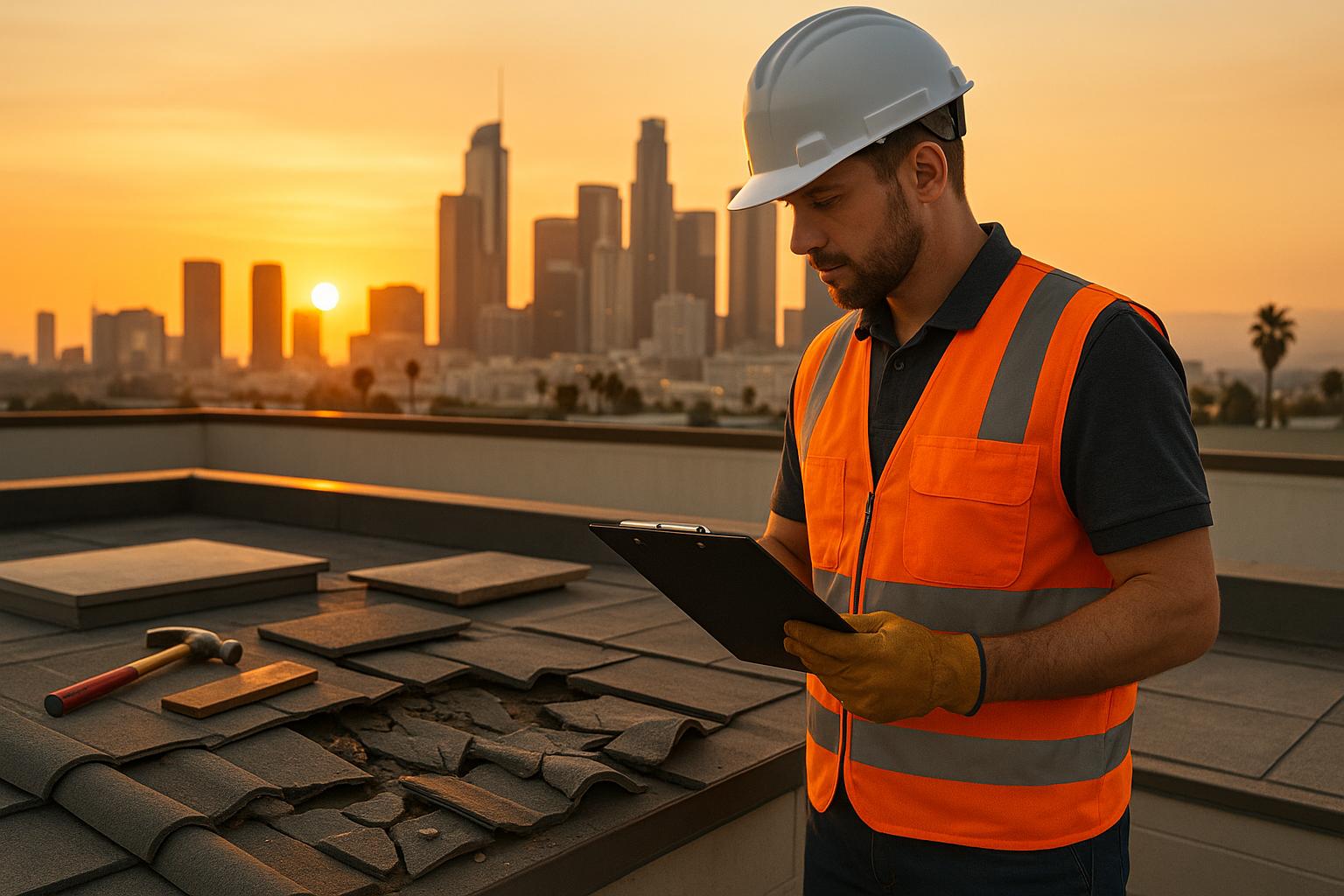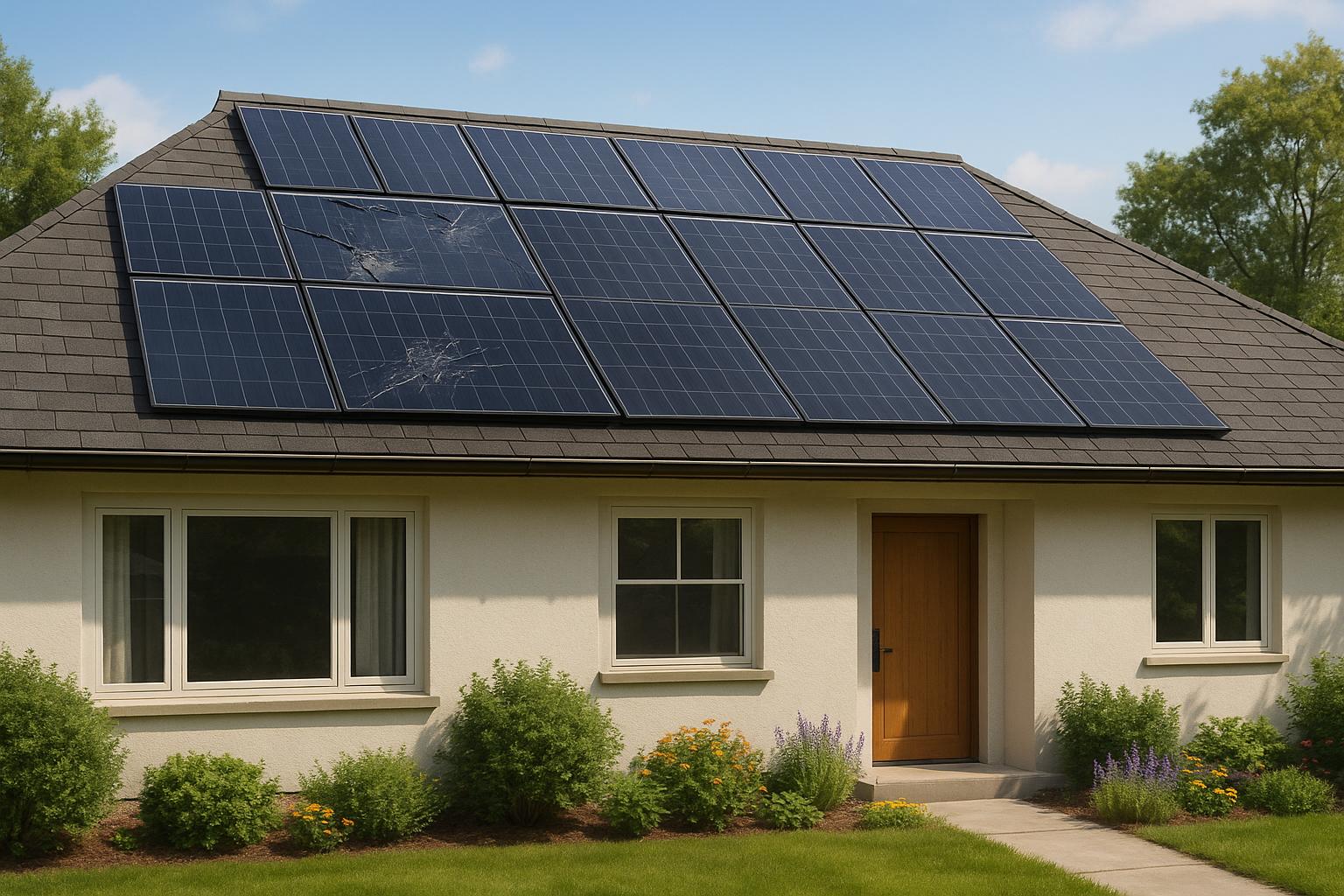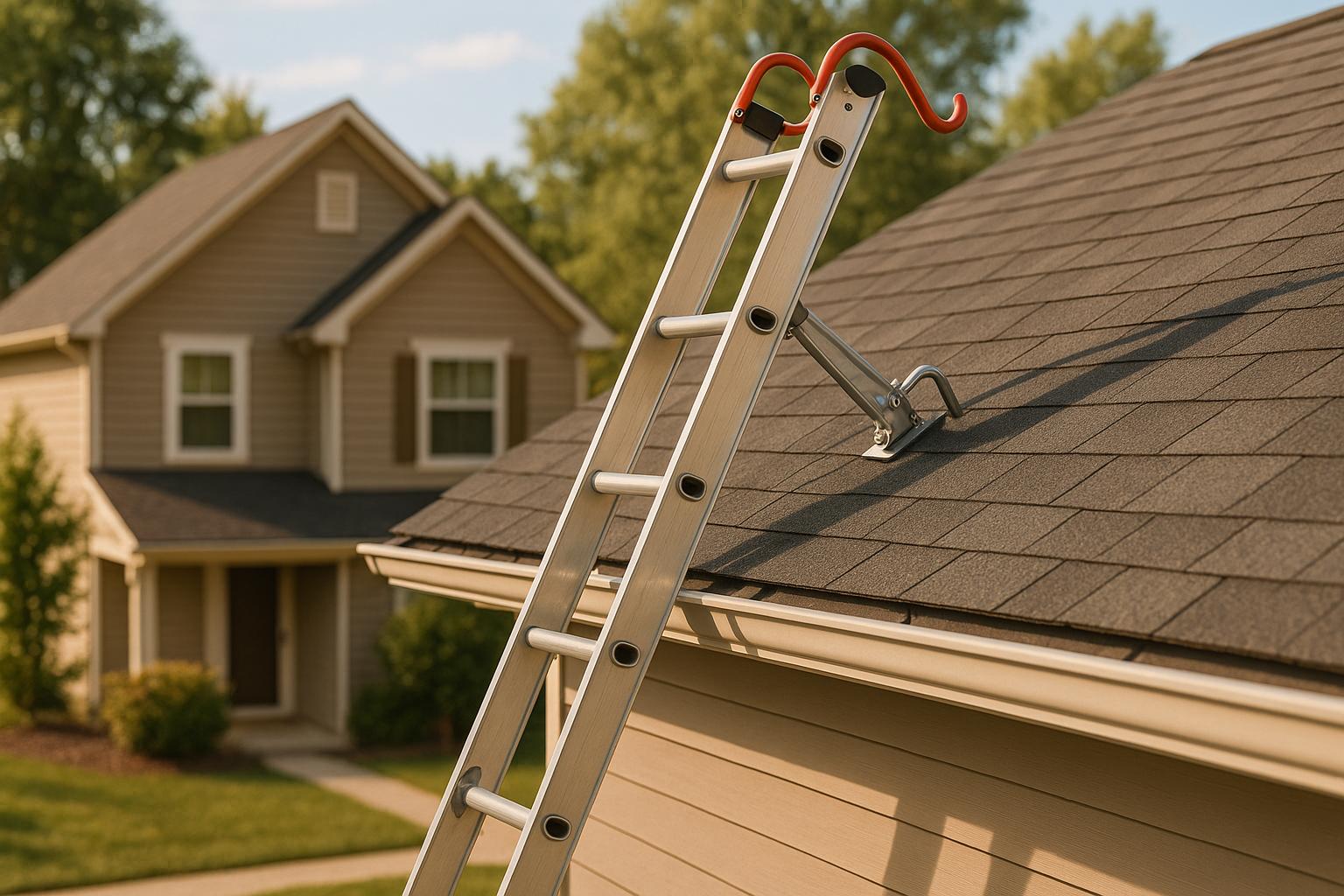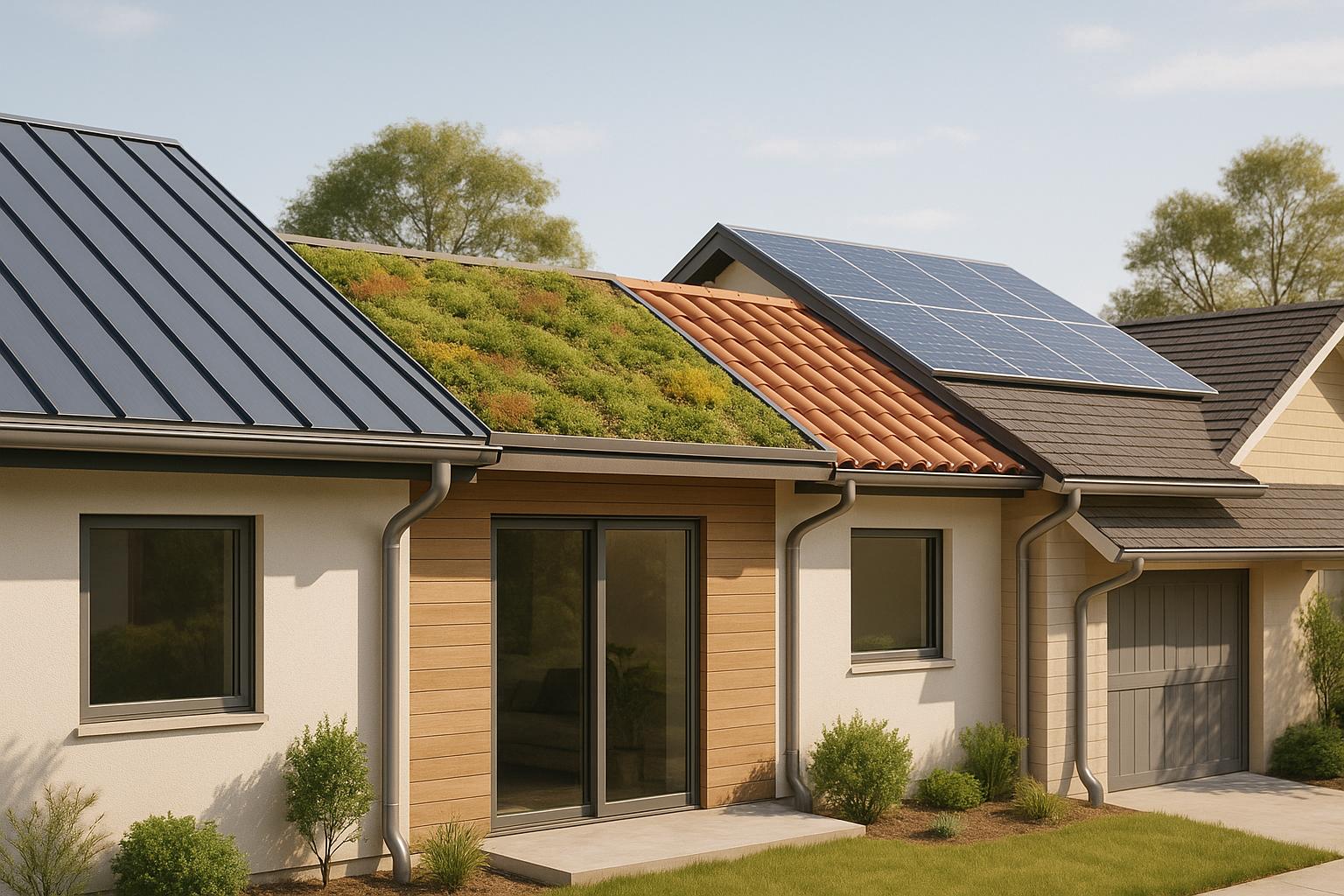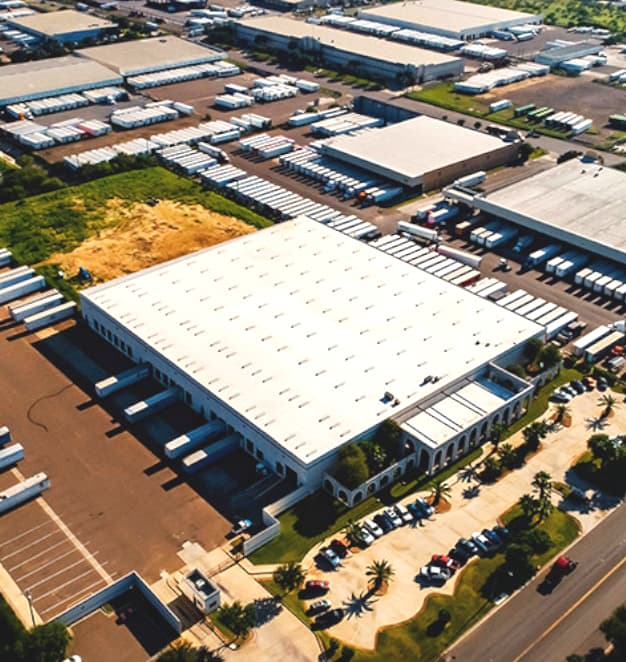Did you know? A small roof leak can cost $150–$500 to fix today but might escalate to a $40,000 replacement in just two years. For businesses in Los Angeles, the stakes are even higher, with risks from heavy rains, strong Santa Ana winds, and wildfires.
Here’s what you need to know to protect your commercial property:
- Common Problems: Storm damage, water leaks, flying debris from Santa Ana winds, and fire risks in wildfire-prone areas.
- Quick Action Steps:
- Use tarps, roofing tape, or liquid coatings for temporary waterproofing.
- Safely remove debris to prevent further damage.
- Document damage with photos and notes for insurance claims.
- LA-Specific Codes: Emergency repairs may require permits, fire-resistant materials (Class A), and compliance with energy-efficient cool roof standards under Title 24.
- Prevention Tips: Schedule roof inspections twice a year, clear debris, and prepare for El Niño rains and high winds.
Key Takeaway: Regular maintenance and prompt repairs save money, reduce risks, and extend your roof’s lifespan.
For more details on protecting your business, keep reading.
5 Things You Need To Know About An Emergency Roof Repair
Common Emergency Roofing Problems in Los Angeles
Los Angeles businesses often face urgent roofing challenges that demand quick action to prevent extensive damage and costly downtime. Knowing the most common issues and their causes can help property owners stay prepared and respond effectively. Here’s a breakdown of the primary emergency roofing problems affecting LA businesses.
Storm Damage and Water Leaks
Heavy rainfall is a leading cause of roofing emergencies for commercial properties in Los Angeles. In fact, storm-related damage accounts for as much as 70% of all commercial roof failures. As Los Angeles Commercial Roof Repair explains:
"When a storm hits, commercial roofs face high winds, heavy rainfall, and flying debris, which can cause significant structural damage." – Los Angeles Commercial Roof Repair
One striking example occurred during a February 2024 atmospheric river event, which dumped over 12 inches of rain in Santa Monica and 13 inches in Bel-Air over four days. This relentless downpour caused water to seep through minor cracks and worn seals, leading to widespread damage. Wind-driven rain worsened the situation by forcing water into these small openings.
The financial toll of such storms is enormous. Experts estimate that a mega-storm driven by an atmospheric river could result in $350 billion in damages and $290 billion in lost business across California. El Niño events further amplify these risks, bringing intense rainfall that overwhelms drainage systems, especially on flat commercial roofs. High winds during these storms only add to the danger, increasing the likelihood of structural failures.
Santa Ana Winds and Flying Debris
Santa Ana winds bring their own set of roofing challenges. These powerful winds, often reaching speeds of 60–70 mph and occasionally exceeding 160 mph, create extreme conditions. Forecaster Luke Stone from OpenSnow highlights their impact:
"Santa Ana winds pose aviation hazards, lead to oppressive temperatures, worsen allergies, cause damage to infrastructure and utilities, and can result in dangerous driving conditions." – Luke Stone, Forecaster, OpenSnow
For roofs, the high-speed winds generate negative pressure, which can lift and tear away roofing materials. Debris carried by the winds – such as tree branches or construction materials – can puncture roofing membranes, creating openings for water to enter. Flashing is particularly vulnerable, as winds can lift it, exposing the roof to further damage. Santa Ana winds are most prevalent in the fall and winter months, and their dry conditions also increase wildfire risks by spreading sparks and embers.
Fire Damage in High-Risk Areas
Wildfires are another major threat to LA businesses, especially those near hillsides, industrial zones, or areas with dense vegetation. Fires like the Eaton and Palisades Fires in January 2025 caused property losses estimated between $35 and $45 billion. Tom Larsen, Senior Director of CoreLogic Insurance Solutions, described the impact:
"The destruction caused by these fires is anticipated to be the most expensive in the state’s history with effects on the insurance industry that will persist into the future." – Tom Larsen, Senior Director of CoreLogic Insurance Solutions
Embers are particularly dangerous, as they can travel up to a quarter-mile and ignite roofs through small gaps. CAL FIRE San Diego Captain Mike Cornette explains:
"As the fire’s moving, that smoke column that’s going up in the air, that’s convective heat. That’s taking that smoke and the heat and embers up in the air, and then there’s a mixture of wind that can carry those embers quite far." – Mike Cornette, CAL FIRE San Diego Captain
Older buildings are especially at risk, with many featuring combustible roofing materials, unsealed gaps, and inadequate ventilation screening that allow embers to penetrate. Prolonged dry spells and heat waves, combined with Santa Ana winds, make matters worse by accelerating the spread of embers and increasing the likelihood of roof deck ignition.
Greg Keeler, Technical Services Leader at Titanium, emphasizes the importance of proactive solutions:
"The more we expand into the WUI, the greater the need for innovative, effective roofing solutions. Contractors have a unique opportunity to make a tangible difference in protecting lives and properties." – Greg Keeler, Technical Services Leader, Titanium
Adding to the difficulty, many insurance companies are now pulling coverage for commercial roofs due to increasing wildfire risks, aging structures, and stricter underwriting standards. This leaves numerous LA businesses vulnerable to devastating financial losses.
Quick Steps to Limit Roof Damage
When storms, high winds, or fires damage your commercial roof, acting swiftly can make a big difference in preventing further harm. Taking immediate, safe measures while waiting for professional repairs is key.
Temporary Waterproofing Methods
Stopping water from entering your building should be your first priority after roof damage. Water intrusion can wreak havoc on inventory, equipment, and the building itself. Here are some temporary solutions to keep water out until permanent repairs can be made:
- Tarps for Large Areas: Cover extensive damage with a tarp that extends well beyond the affected area. This helps block rain, snow, and wind. Avoid using nails or staples to secure the tarp, as they can create additional holes. Instead, use weighted edges or tie the tarp to sturdy anchor points. Keep the tarp as flat as possible to prevent water pooling.
- Polyethylene Sheets for Small Holes: For minor cracks or holes, polyethylene sheets can work well. Attach them with roofing nails, weigh them down with rocks, or secure them using heavy-duty duct tape. Be sure to clean the area before applying any patching material to ensure it sticks properly.
- Roofing Tape: If you prefer not to access the roof, roofing tape can be applied from inside the attic to seal small leaks.
- Liquid Roof Coatings: When applied correctly, these can provide a temporary seal.
Always prioritize safety. Avoid working on wet, slippery, or unstable roofs, and use proper equipment like a harness and a sturdy ladder. Once you’ve secured waterproofing, clear any debris to reduce additional strain on the roof.
Safe Debris Removal
Removing debris from a damaged roof requires caution to avoid worsening the damage or endangering yourself.
Start by assessing the roof’s safety. Check for loose shingles, cracks, or structural instability. Only work on debris removal during calm, dry weather to minimize risks. Wet or windy conditions can make the task dangerous.
Use a stable ladder, wear non-slip shoes, and secure yourself with a safety harness. Having someone on the ground to assist and monitor adds an extra layer of safety.
For debris removal, opt for gentle methods. Soft-bristle brushes or brooms are ideal for clearing leaves, branches, and dirt without harming the roof. Avoid power washing, as the high-pressure water can push moisture under shingles and worsen the damage.
If you encounter large debris, such as big branches or structural pieces, call professionals who have the right tools and expertise. Regularly clearing debris as part of routine maintenance can also help prevent future damage. After clearing the roof, document all visible damage to support your insurance claim.
Recording Damage for Insurance
Once temporary repairs and debris removal are complete, documenting the damage is crucial for a smooth insurance claim process. Clear and detailed evidence ensures accurate assessments by insurers and helps avoid delays or denials.
Start by taking timestamped photos or videos of the damage as soon as possible. Include notes about the incident, such as the weather conditions and the extent of the damage. Begin your inspection from the ground with binoculars to identify affected areas safely, leaving roof access to professionals.
Capture wide-angle shots to show the overall damage, then zoom in on specific problem areas and any interior damage caused by leaks. Maintain detailed written records, including notes from conversations with contractors or insurance representatives. A professional inspection and estimate from a licensed roofing contractor can strengthen your claim, as insurers often rely on expert documentation.
If possible, establish a baseline by photographing your roof when it’s in good condition. These before-and-after comparisons can be incredibly helpful during a claim. Submit all documentation – photos, videos, written records, and contractor estimates – promptly to your insurance company to ensure fair compensation for repairs.
Los Angeles Roofing Code Requirements
Understanding roofing codes in Los Angeles is essential when handling emergency repairs. These regulations not only keep your business compliant but also safeguard your property and employees. While the permit process and material standards might feel complex during a crisis, having a basic grasp of the rules can help you make quick, informed decisions.
When Permits Are Required for Emergency Repairs
Not every emergency roof repair needs a permit, but knowing when one is required can save you from costly delays or violations. Generally, a permit is mandatory for any work that impacts the structural integrity of your roof. On the other hand, minor fixes like small patches or temporary waterproofing measures, such as tarping, usually don’t require permits since they’re classified as maintenance rather than construction.
For more significant repairs, such as fixing structural damage, replacing large sections of membrane, or working on the roof deck, permits are typically required. The Los Angeles Department of Building and Safety (LADBS) evaluates permit needs on a case-by-case basis. If you’re unsure, it’s best to consult LADBS directly or work with a licensed contractor familiar with local regulations.
To streamline the process, Los Angeles County offers an online permitting portal called EPIC-LA. This can help speed things up, especially during emergencies. Contractors experienced with LA’s permitting system can also handle the paperwork for you, allowing you to focus on restoring your business. Once permits are sorted out, the next step is ensuring your materials meet fire-resistance standards.
Fire-Resistant Material Requirements
In Los Angeles, fire safety is a priority, especially given the region’s history with wildfires. To put things into perspective, more than 58,000 fires burned approximately nine million acres across the U.S. in 2018, with California taking the brunt of the damage. That year, over 18,000 homes and 229 commercial buildings were destroyed. Fast forward to 2020, and California saw its five largest wildfires, causing damages estimated at $10 billion. This history has shaped California’s strict roofing material standards for commercial properties.
California’s Building Code Chapter 7A focuses on reducing wildfire risks and applies to new developments in high-risk zones, such as State Responsibility Areas (SRAs) and the most fire-prone Local Responsibility Areas (LRAs). For commercial properties in Very High Fire Hazard Severity Zones, specific material requirements are enforced.
Under the Los Angeles County Building Code (LACBC), Chapter 15, Sections 1505.1 and 1505.2, roofs must meet Class A standards. If more than 50% of a roof is replaced within a year in high-risk areas, the entire roof must be upgraded to a Class A assembly.
Class A materials, which provide the highest level of fire resistance, are tested to endure direct flames, intense heat, and radiant energy. Noncombustible options like metal roofing (steel, aluminum, or copper) are common choices. Other approved materials include slate, synthetic shingles, and clay or concrete tiles.
"These California wildfires remind us that no community is immune to disaster. It’s time to rethink how we build, using fire-resistant materials and protocols to protect lives and homes in California." – Robert J. Pierson, CEO, Ecohome Network Inc
When planning emergency repairs in fire-prone areas, opting for Class A materials from the start not only ensures compliance but also offers superior protection for your property. Once fire safety is addressed, the next focus should be on meeting energy efficiency standards under Title 24.
Cool Roof Rules Under Title 24
After fire safety, energy efficiency takes center stage. California’s Title 24 outlines specific cool roof standards that apply to both new installations and emergency repairs. These rules aim to reduce energy consumption and combat the urban heat island effect.
Cool roofs are designed to reflect more sunlight and absorb less heat, which helps lower energy costs. Title 24 regulations kick in when more than 50% of a roof or over 2,000 square feet is replaced or recoated. All cool roofing materials must be certified by the Cool Roof Rating Council (CRRC) to meet solar reflectance and thermal emittance requirements.
For commercial roofs, Title 24 specifies a minimum initial thermal emittance of 75% and an initial solar reflectance of 70%, according to CRRC ratings. In Los Angeles, asphalt shingles for both residential and commercial buildings must meet or exceed a Solar Reflectance Index (SRI) value of 20 for new construction and reroofing projects. In unincorporated areas, asphalt shingles must meet a 3-year aged solar reflectance value of 0.25 and an initial thermal emittance value of 0.85, or an SRI value of 20.
The California Energy Commission updates Title 24 every three years, with the next revision scheduled for 2025. Staying informed about these updates is crucial to avoid compliance issues during emergency repairs.
If your emergency repair triggers Title 24 requirements, ensure your roofing materials are CRRC-rated. Partnering with contractors who understand these energy efficiency standards can help you meet the regulations while protecting your investment.
sbb-itb-d1d6490
How to Pick a Good Emergency Roofing Contractor
When your commercial roof is damaged, choosing the right contractor is essential to avoid poor repairs, code violations, and unnecessary delays. Knowing what to look for in an emergency roofing contractor can save you both time and money.
24/7 Emergency Service Availability
A true 24/7 emergency service is more than just a claim – it’s about actual responsiveness. If a contractor relies on automated responses during off-hours, consider it a warning sign. Look for providers who guarantee quick and dedicated emergency responses. For instance, at Prime American Roofing, the team is available around the clock to handle any roofing crisis promptly.
When assessing contractors, ask about their experience with Los Angeles’ specific weather challenges. From Santa Ana winds to sudden heavy rains and fire damage, each requires a tailored repair approach. A contractor familiar with these conditions should be able to provide references from similar projects. This initial vetting process helps confirm their technical expertise and ensures they can meet Los Angeles’ rigorous building codes.
Code Knowledge and Experience
Los Angeles has complex building codes, and emergency repairs often require permits and strict compliance. In California, any roofing work exceeding $500 (materials and labor combined) must be performed by a contractor with a C-39 roofing license. This license, issued by the Contractors State License Board (CSLB), requires the qualifying individual to have at least four years of experience. You can verify a contractor’s license online through the CSLB website or by calling (800) 321-2752.
Older buildings may present additional challenges, such as hazardous materials like asbestos. Contractors working with these substances need specific certifications and must register with the Asbestos Contractor Registration Unit of DOSH. The qualifying individual listed on the license is ultimately responsible for the contractor’s compliance with construction operations and regulations.
When interviewing contractors, ask about their familiarity with local codes, including Title 24 cool roof requirements and Class A fire-resistant materials. Their understanding of these regulations can help you avoid compliance issues that might delay repairs. This expertise is just as critical as the quality of materials they use, which brings us to the next point.
Access to Quality Materials
For businesses in Los Angeles, access to high-quality materials is just as important as technical expertise and timely service. Experienced roofing contractors often have strong relationships with suppliers, giving them access to premium materials that might not be available to the general public. This is especially valuable during emergencies when standard supplies could be backordered.
Using top-tier materials ensures greater durability, energy efficiency, and safety, ultimately reducing future repair costs. A skilled contractor will address the root causes of damage, minimizing the likelihood of future issues.
Focus on materials specifically designed to withstand LA’s climate. Ask contractors about warranties – both for the materials themselves and for their workmanship. It’s also a good idea to request photos or addresses of recent projects to evaluate their work quality firsthand. Additionally, a contractor’s financial stability can be a good indicator of their ability to secure quality materials quickly, even during high-demand periods.
How to Prevent Future Emergency Repairs
To avoid roofing emergencies, it’s crucial to tackle Los Angeles’ unique weather conditions with proactive maintenance. As Oscar Marin, Emergency Operations Manager in Yuba County, CA, wisely put it:
"The more you do ahead of time, the more peace-of-mind you will have when a crisis arises."
Preparing for El Niño and Heavy Rain
El Niño years often bring heavy rainfall, which can overwhelm roofs that aren’t ready to handle the challenge. Start by clearing gutters and downspouts to ensure proper drainage. Inspect roof seams, fields, and penetrations for any gaps that could worsen under the strain of intense rain. Seal these vulnerable areas and schedule a pre-season roof inspection to address potential weaknesses. If your roof is aging or showing significant wear, consider replacing it with weather-resistant materials to better withstand the elements.
Once you’re ready for the rain, shift your focus to protecting your roof against high winds.
Wind Protection for Santa Ana Conditions
Santa Ana winds are notorious for their strength, sometimes reaching speeds of over 70 mph. These winds can turn loose debris into dangerous projectiles, causing significant damage. To prepare, reinforce roof edges with wind-resistant flashing and additional fasteners. For flat roofs, opt for durable materials such as metal, modified bitumen, built-up systems, or single-ply membranes like TPO or EPDM. During the Santa Ana season, schedule regular inspections with a focus on areas prone to damage. Acting quickly on any identified issues can prevent small problems from escalating. Additionally, create an emergency plan to secure loose items and document your roof’s condition before storms hit.
After addressing wind protection, establish a routine inspection schedule to keep your roof in top shape year-round.
Establishing Regular Roof Inspections
Twice-yearly roof inspections – ideally in spring and fall – are a smart investment, typically costing between $120 and $400. These inspections help catch small issues before they turn into costly repairs. Key areas to focus on include clearing debris, checking flashings, and assessing UV damage. In Los Angeles, where intense sunlight can speed up roof deterioration, these checks are especially important. Professional inspections also ensure your roof complies with local building codes and satisfies insurance requirements.
"Scheduling regular roof inspections can help business owners spot potential issues before they escalate, saving on costly repairs or even a total roof replacement." – Georgia Restaurant Association
Address any problems uncovered during inspections promptly to avoid further damage and potential disputes with your insurance provider. A well-maintained roof not only protects your building but can also improve energy efficiency, helping to lower utility costs. Prime American Roofing offers thorough inspection services designed to help Los Angeles businesses meet local requirements and weather severe conditions. By prioritizing preventive care, you can minimize emergencies, reduce insurance premiums, and ensure your operations continue uninterrupted.
Conclusion: Protect Your Business with Smart Roofing Care
Your commercial roof is more than just a protective barrier – it’s a significant investment that demands attention and care. Ignoring small issues, like leaks, can lead to massive expenses. For instance, a repair costing $150–$500 today could balloon into a $40,000 roof replacement if left unaddressed for just two years. Poor maintenance doesn’t just add costs – it can dramatically shorten your roof’s lifespan.
Timely repairs and consistent care aren’t just smart – they’re financially essential. Emergency repairs often cost more than twice as much as planned maintenance. With proper upkeep, a commercial roof can last 20 years or more, while neglect could reduce that lifespan to just five to seven years. In fact, regular maintenance can add an extra 5–10 years to your roof’s life and help maintain your property’s value, whether you’re selling or leasing.
For businesses in Los Angeles, the stakes are even higher. The region’s intense UV exposure, Santa Ana winds, and seasonal storms can wreak havoc on roofs. Heat-resistant sealants, reflective coatings, and UV-stable materials are critical to combat these challenges. Additionally, reinforcing seams and securing membrane systems becomes especially important during high-wind events like Santa Ana conditions.
The best way to avoid costly surprises? Stay proactive. Schedule inspections twice a year, address minor issues immediately, and keep detailed records of all repairs. This routine not only extends your roof’s lifespan but also ensures compliance with warranties and local building codes, while preventing minor problems from turning into major disruptions.
FAQs
What are the roofing codes and permit requirements for emergency repairs in Los Angeles, and how can my business stay compliant?
Emergency Roofing Repairs in Los Angeles: What You Need to Know
In Los Angeles, commercial property owners dealing with emergency roofing repairs must navigate local building codes and, in many cases, secure permits. The Los Angeles Department of Building and Safety (LADBS) requires permits for most construction, alteration, or repair projects – including emergency fixes – to ensure both safety and compliance with city regulations.
Although minor repairs might not always demand a permit, it’s crucial to check with local authorities to avoid complications down the line. Additionally, the California Building Code outlines specific standards for roofing systems, which must be adhered to during any repair work to maintain both safety and structural stability.
Hiring a licensed contractor who understands Los Angeles codes and the permitting process can make all the difference. They’ll not only guide you through the necessary steps but also handle the paperwork, allowing you to focus on resolving the emergency with confidence.
How can businesses in Los Angeles prepare their roofs for Santa Ana winds and heavy El Niño rains?
Los Angeles businesses face unique weather challenges, from the powerful Santa Ana winds to the heavy rains brought by El Niño. Taking a few precautionary steps can go a long way in protecting your roof and avoiding costly repairs.
For the Santa Ana winds, which can whip through the area at speeds exceeding 80 mph, it’s crucial to secure rooftop equipment like HVAC units, clear away debris, and check for loose shingles or damaged flashing. Trimming nearby trees is another smart move – it reduces the risk of branches breaking off and causing damage during high winds.
El Niño’s downpours, on the other hand, call for a different set of preparations. Regular roof inspections can help catch leaks early, while cleaning out gutters ensures water doesn’t pool where it could lead to serious issues. Make sure your drainage systems are working properly to handle the extra water. Additionally, upgrading to durable, wind-resistant roofing materials can provide added protection and help cut down on future repair costs.
Staying ahead of these weather challenges with proactive maintenance can help keep your roof in good shape and your business running smoothly.
What should I consider when choosing an emergency roofing contractor in Los Angeles, and how can I confirm they’re qualified to handle local weather challenges?
When you’re selecting an emergency roofing contractor in Los Angeles, it’s crucial to prioritize their familiarity with local roofing systems and their knowledge of the area’s unique weather patterns. Los Angeles roofs must endure intense sunlight, occasional heavy rains, and strong winds, so having a contractor who understands these conditions is essential.
Some key things to look for include a valid California license, comprehensive insurance (covering both liability and workers’ compensation), and a solid reputation backed by positive reviews from local customers.
To ensure they’re qualified, check their license status through the California State License Board (CSLB) and ask for proof of insurance. It’s also a good idea to request references or examples of previous projects to confirm they have experience handling similar roofing issues. Taking these steps will help you choose a contractor who can tackle Los Angeles’ roofing challenges efficiently and with professionalism.

